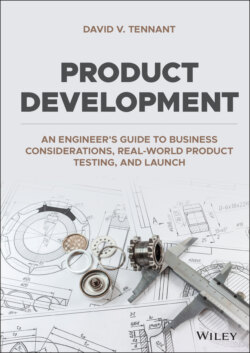Читать книгу Product Development - David V. Tennant - Страница 37
Answers to Discussion Questions
Оглавление1 The project leader has an important role. While all of the below are important, which is the most important and why:CommunicationsIntegrity and trustConflict resolution? While each answer is important, the correct answer is b. A project or product manager is a leadership role, and one of the principal hallmarks of leadership is trust. This will be of high importance in leading a product development team to success.
2 Some companies believe that a Product Development Manager must have strong technical skills. Is this true? Why or why not?The Product Manager will need leadership and managerial expertise more that technical expertise. The PM should expect to have technical subject matter experts (SME) assigned to the team. The required PMs skills include vision and focus on the objectives, strong communications and relationship building up and down the organization, managerial excellence, ability to track budgets and schedules, and the ability to resolve conflict. There are additional skills that could be listed, but these are the fundamentals.
3 What value does the Marketing Group bring to the product development effort?Marketing may assign a Product Manager to lead the development effortMarketing tracks industry trends and determines the 4 PsMarketing will develop pricing/margin scenario spreadsheetsMarketing will determine the break-even pointIt is likely that marketing will work with the finance group to determine NPV and other financial metrics
4 If the cost of each new product is $40, and our company expects margins of 25%, should we price our product at $50? Why or why not?At a cost of $40 and a selling price of $50, the required 25% margin will be realized. However, there is no guarantee that $50 will be accepted by the market. If the price, for example, must be dropped to $45 to sell, then the required margin will not be met. The company would then need to determine if a 20% margin is acceptable or find ways to cut costs so that the required profitability can be obtained.
5 One of the costs that may be in our product’s development is legal costs. What kind of legal activities would be in our budget?The legal department, depending on the product, may have a very key role to play in product development. Some of the activities may include:Developing and reviewing contracts with suppliersSubmitting patents for the new product(s)Determining intellectual property ownership and if royalties will be paidRegistering trademarks or copyrightsOutlining contracts or guidelines for product distribution rightsAdvising the product team and senior management of potential legal (product liability) or regulatory issues.
6 Why is it important to know the break-even point?Breakeven is related to profitability and NPV (net present value). It is important to know the breakeven point (the point where all costs are recovered, and the new product is profitable):If the breakeven point is too long (say 10 years), this may not be acceptable and prove to be a money-losing product. A long breakeven point will give competitors time to catch up and almost guarantee that your product will never meet margins.Each company is unique and will determine what is an acceptable breakeven based on time, NPV, costs, and price.
7 What are methods to anticipate customer demand and pricing?Customer focus groups.Brand and reputation of companyNote that brand recognition can offer the perception of quality, thereby allowing a higher selling price.Evaluating market acceptance based on similar products from competitors.Studying history of previously released products by your company. This may provide insight into pricing and market acceptance.
8 Projects should always exist to support the corporation’s strategy. Why?The company develops a strategy, or long-term plan, to remain profitable. The corporation issues new products that capitalize on its strengths. Consequently, all activities: projects, new product development, etc. should support the corporation’s strategy. If a new product is not part of the strategic plan, why should it be funded or supported?
9 Once products have reached the decline stage in the product lifecycle, they become a commodity. Is this true? What is a commodity?In the traditional sense, commodities are defined as base or raw materials. This includes items such as oil, wheat, sugar, gold, etc. These are considered primary commodities. However, secondary commodities include products that are produced using primary commodities, such as gasoline and plastics from oil, cereal and bread from wheat, etc. Commodities, unprocessed, are placed into three categories: agriculture, energy, and metals.To a lesser degree, products once they reach their maximum potential may be called a commodity, but this is not in the strict definition. This basically means that a product in “commodity” status is simply not able to command a high price and must compete with many other producers.
10 All costs in a product’s development should be recovered in the first year of a product’s sale in the marketplace. Is this a good strategy? Why or why not?This is an unrealistic expectation. The goal, of course, is to recover all costs and meet the breakeven point as quickly as possible. For more sophisticated products – e.g., newly developed cars (Tesla, for example), sophisticated electronics, and specialized applications (medical equipment) – the breakeven point will be longer. It is up to each company to determine an appropriate time frame to recover costs and become profitable.It is safe to assume that most companies will not expect cost recovery in the first year.
